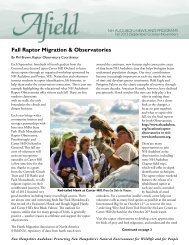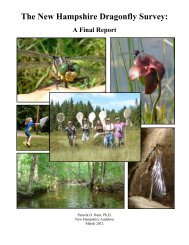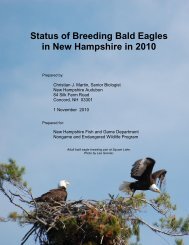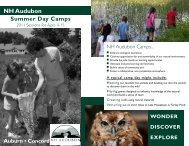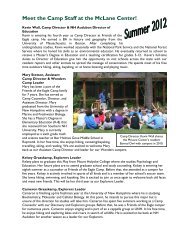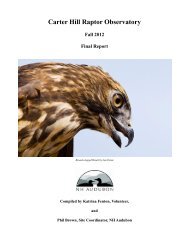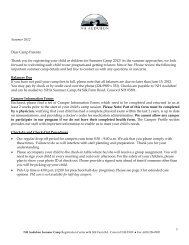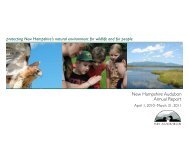2012 Annual Report - New Hampshire Audubon
2012 Annual Report - New Hampshire Audubon
2012 Annual Report - New Hampshire Audubon
- No tags were found...
You also want an ePaper? Increase the reach of your titles
YUMPU automatically turns print PDFs into web optimized ePapers that Google loves.
The highest concentration of harriers occurred in the week-long period between October 20-26, in which36 of the season’s 87 migrants (41.4%) were spotted. These dates are somewhat later than similar“pushes” in past years, though the factors involved in migration timing are multiple and complex. Giventhat the harrier’s migration is drawn out over many months—some birds begin moving south in July;others will still be moving in December—hopes ran high for significant harrier numbers after the finish ofthe official count period. In light of that, the two harriers seen in November seem a remarkably lownumber. And by comparison with the elevated numbers of other raptor species seen this fall, the 87 totalharriers is none too impressive. The population of this bird in the East is shown to be holding steady orslightly declining, and relevant data from Pack will be important in fleshing out the larger picture in yearsto come.Adult Male Northern Harrier Photo by Jo-Ann Matthews — Juvenile Northern Harrier Photo by Katrina FentonRed-tailed Hawk (Buteo jamaciensis)<strong>2012</strong> Season Total: 378 [August: 6 [November: 138<strong>New</strong> Season Record2005-11 Average: 245 [Previous Record Highs: 361 (2009); 308 (2010)Tied Single-day Record: 53 (Oct. 24) [Previous Single-day Highs: 53 (10/27/06); 50 (10/31/10)Many a slow afternoon of hawk-watching may be whiled away studying the statuesque pose of a RedtailedHawk, stalled in mid-air, wings tucked, head down, with only a quick adjustment of a tail feather ortwo to balance against the shifting breeze. This behavior, called “kiting,” is effectively a kind of perchhuntingwithout a perch. One need not watch the display for many minutes before realizing the instinctiveprecision such behavior requires: not simply a friendly association with the wind, but a total harnessing ofit to suit the bird’s purposes. A red-tail perched along the verge of a highway or the edge of a farm fieldmay give the impression of a plump, sedentary, sluggish, rather complacent hawk, but given a glimpse ofit hunting for red squirrels over the spruce woods of Pack Monadnock, a birder begins to change his tune.12



